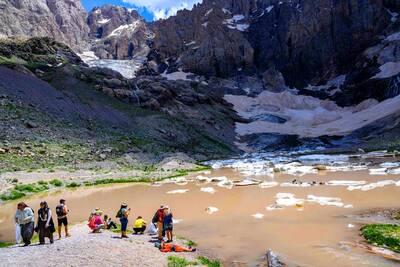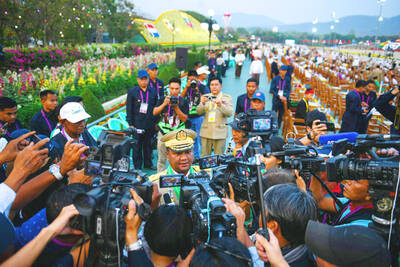Neanderthals and modern humans interbred, probably when early humans first began to migrate out of Africa, according to a genetic study released on Thursday.
People of European, Asian and Australasian origin all have Neanderthal DNA, but not Africans, researchers reported in yesterday’s issue of the journal Science.
The study may help resolve the long-running debate over whether Neanderthals and modern humans did more than simply live side by side in Europe and the Middle East.
“Those of us who live outside Africa carry a little Neanderthal DNA in us,” said Svante Paabo of the Max Planck Institute in Munich, Germany, who led the study.
“The proportion of Neanderthal-inherited genetic material is about 1 to 4 percent. It is a small but very real proportion of ancestry in non-Africans today,” David Reich of Harvard Medical School in Boston, who worked on the study, told reporters in a telephone briefing.
While the findings may lead to jokes about cave-man behavior or looks, Paabo said his team cannot identify any Neanderthal “traits.”
“As far as we can tell these are just random pieces of DNA,” he said.
The researchers used modern methods called whole genome sequencing to examine the DNA from Neanderthal bones found in Croatia, Russia, Germany and Spain, including some crushed leg bones from one Croatian cave that some scientists believe are evidence of cannibalism.
The researchers developed new methods to gather, distinguish and sequence the Neanderthal DNA.
“In those bones that are 30,000, 40,000 years old there is of course very little DNA preserved,” Paabo said.
He said 97 percent or more of the DNA extracted was from bacteria and fungi.
They compared the Neanderthal sequences with DNA sequences from five people from Europe, Asia, Papua New Guinea and Africa.
“Their analysis shows the power of comparative genomics and brings new insights to our understanding of human evolution,” Eric Green, director of the National Human Genome Research Institute at the National Institutes of Health, said in a statement.
The results add to a picture of modern humans living alongside with and interacting on the most intimate levels with similar humans who have now gone extinct.
“It certainly is an indication of what went on socially when Neanderthals and modern humans met,” Paabo said.
“There was interbreeding at some little level. I would prefer to leave it to others who want to quarrel over whether to call us separate species or not,” he said. “They were not genetically very distinct from us.”
The DNA sequences date back to somewhere around 80,000 years ago, when modern humans moving through the Middle East on their way out of Africa would have encountered Neanderthal populations.
The researchers identified five genes unique to Neanderthals, including three skin genes.
“This suggests that something in the physiology or morphology of the skin has changed in humans,” Paabo said.
In March Paabo and colleagues reported they had found a previously unknown human species that lived 30,000 years ago alongside modern humans and Neanderthals in Siberia.
Scientists have speculated that different species of humans lived side by side at various times over the past million years. But many would have lived in tropical zones where bones are not easily preserved.
Paabo said modern-day Africans may carry some of that unknown DNA even if they do not have Neanderthal ancestors.

In the sweltering streets of Jakarta, buskers carry towering, hollow puppets and pass around a bucket for donations. Now, they fear becoming outlaws. City authorities said they would crack down on use of the sacred ondel-ondel puppets, which can stand as tall as a truck, and they are drafting legislation to remove what they view as a street nuisance. Performances featuring the puppets — originally used by Jakarta’s Betawi people to ward off evil spirits — would be allowed only at set events. The ban could leave many ondel-ondel buskers in Jakarta jobless. “I am confused and anxious. I fear getting raided or even

Kemal Ozdemir looked up at the bare peaks of Mount Cilo in Turkey’s Kurdish majority southeast. “There were glaciers 10 years ago,” he recalled under a cloudless sky. A mountain guide for 15 years, Ozdemir then turned toward the torrent carrying dozens of blocks of ice below a slope covered with grass and rocks — a sign of glacier loss being exacerbated by global warming. “You can see that there are quite a few pieces of glacier in the water right now ... the reason why the waterfalls flow lushly actually shows us how fast the ice is melting,” he said.

RISING RACISM: A Japanese group called on China to assure safety in the country, while the Chinese embassy in Tokyo urged action against a ‘surge in xenophobia’ A Japanese woman living in China was attacked and injured by a man in a subway station in Suzhou, China, Japanese media said, hours after two Chinese men were seriously injured in violence in Tokyo. The attacks on Thursday raised concern about xenophobic sentiment in China and Japan that have been blamed for assaults in both countries. It was the third attack involving Japanese living in China since last year. In the two previous cases in China, Chinese authorities have insisted they were isolated incidents. Japanese broadcaster NHK did not identify the woman injured in Suzhou by name, but, citing the Japanese

RESTRUCTURE: Myanmar’s military has ended emergency rule and announced plans for elections in December, but critics said the move aims to entrench junta control Myanmar’s military government announced on Thursday that it was ending the state of emergency declared after it seized power in 2021 and would restructure administrative bodies to prepare for the new election at the end of the year. However, the polls planned for an unspecified date in December face serious obstacles, including a civil war raging over most of the country and pledges by opponents of the military rule to derail the election because they believe it can be neither free nor fair. Under the restructuring, Myanmar’s junta chief Min Aung Hlaing is giving up two posts, but would stay at the